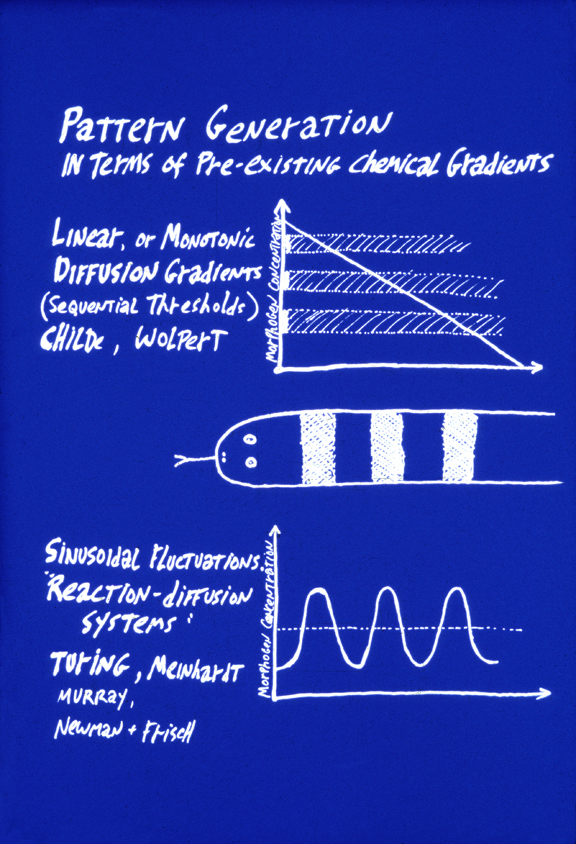January 25: Experimental Embryology
Started in the late 1800s: Leading researchers included:
-
Hans Spemann,
Wilhelm Roux,
Hans Driesch,
Ross Harrison,
H.V. Wilson,
Hans Holtfreter
(Of course, we all know that isn't how differentiation works; but it had to be tested. It would not be impossible for differentiation to work that way; maybe life on some other planet uses that kind of method to cause cell differentiation.
(Actually, it is sort of surprising that method never evolved on earth.)
Spemann's experiment tying a human hair around an amphibian embryo at the one cell stage:
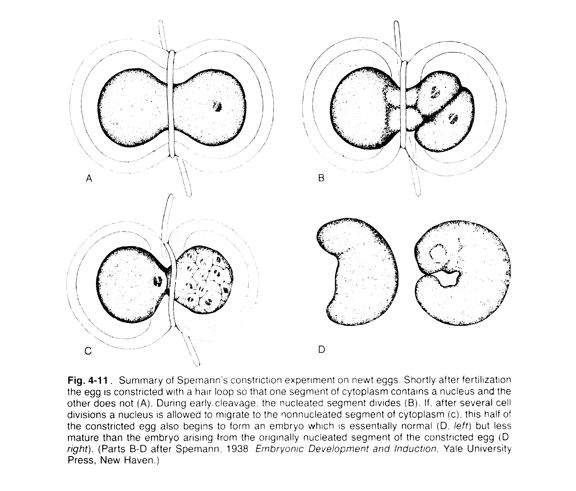
***********************************
Roux "hot needle" experiment (~1880s)
Wilhelm Roux did a famous experiment intended to confirm the theory of different parts of each embryo getting only certain genes. He poked red-hot needles into 4 or the first 8 cells or early frog embryos; or sometimes poked hot needles into 2 of the first 4 cells, or 1 of the first 2 cells.The idea was to kill or severely damage half the cells of an early embryo, with the expectation that the undamaged cells would continue and develop into the same tissues that they normally form, even though the "killed" cells failed to differentiate.
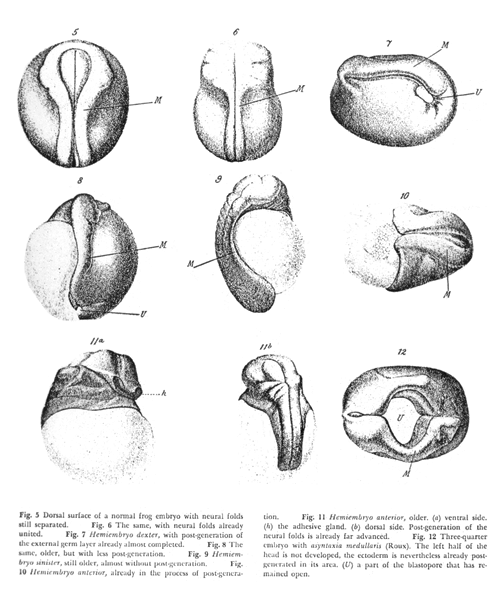
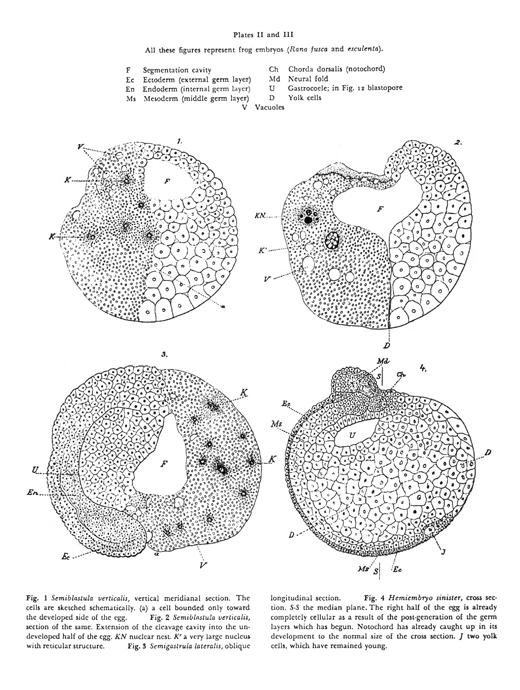
Textbooks use the verb "killed" to refer to the effect of the hot needle on embryonic frog cells. Actually, the original paper says the "killed" cells were still alive, and that after several hours they began to divide again.
Anyway, people interpreted the result as support for the idea of different genes being distributed unequally to different cells. (Nobody really understands the results of this experiment, but it has been repeated with the same results)
***********************************

Ten years later, in the 1890s, Hans Driesch, tried another experiment to test the same theory. He shook water that had 2 and 4 cell starfish embryos in it. Some of their cells got separated apart. He expected they should develop into half embryos or quarter embryos.
The results astounded Driesch (and everybody else).
When the first 2 cells separated, each developed into a half-sized, normally proportioned pluteus. If one of the first 4 cells were separated, it developed into a quarter-sized, but normally proportioned pluteus, with each part a quarter normal size.
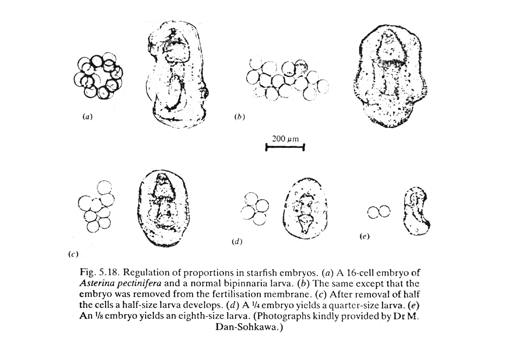
This disproved the theory of different parts of embryos receiving different genes.
But even today scientists don't really understand the mechanism that changes the sizes of parts of embryos in proportion to the size of the whole embryo.
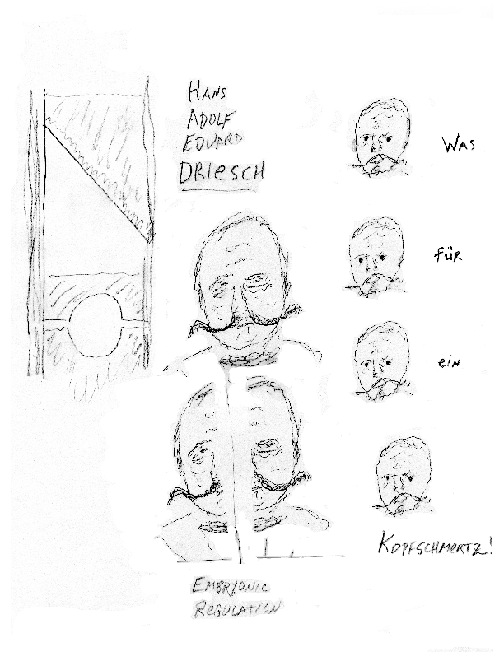
***********************************
"Embryonic Regulation"
But please don't be misled by the word "regulation",which can seem to imply some exterior control telling somebody what to do.
This kind of regulation is internal adjustment, to fix damage or overcome abnormality or effects of some external disturbance.

If you are willing to include cellular slime mold amoebae, and their formation of stalked "fruiting bodies" as an example of something like embryos, then their development is the most regulative of all, because you can cut a Dictyostelium "slug" into 10 or 100 pieces, and the cells of each fragment will reorganize to form a normally-proportioned slug, and then a scale model stalk and spore mass, one one-hundredth the size the original "slug" would have formed.
>
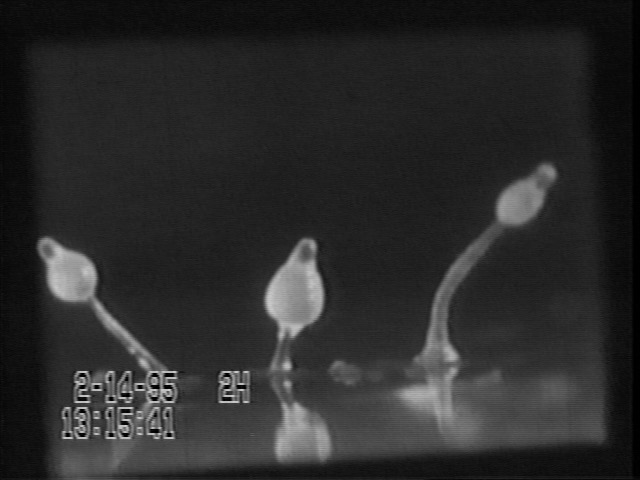
(Please understand that these "slugs" are masses of a kind of amoebae, & only happen to resemble real slugs, which are a kind of snail.)
Dictyostelium discoideum is the most-studied one of the "Cellular Slime Molds". In one stage of their life cycle, a culture consists of small amoeboid cells that move around, eating bacteria. When they run out of bacteria, they aggregate by chemotaxis, and form multicellular "slugs" that can crawl around. The slugs vary widely in size, depending on how many individual amoebae aggregated to form them. They then differentiate into stationary "fruiting bodies" that consist of a tapering stalk, with a lemon-shaped mass of spores at the top, and have the same proportions over a size range of at least 500. This is even more than Driesch's revolutionary discovery that starfish embryos can "scale" over a sixteen-fold size range. (Incidentally, this most-studied species was discovered by a UNC undergraduate [Kenneth Raper] on some horse dung in Duke Forest) For many years, the leading researcher on slime molds was Lindsay Olive, who was a professor in this department, and kindly provided many different species to use in laboratories of this course.
There will be a Biology 441L lab on Dictyostelium in a few weeks.

Whatever adjustments cause regulation of shape and adjustment of proportionality of sizes, sometimes requires time to adjust.

----------------------------------
Embryonic control mechanisms, for some unknown reason, requires that tissues be under tension.


----------------------------------
Sometimes embryonic regulation is of a different kind.
Cells go to the same end point, even if surgically moved to an abnormal location.


